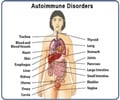New study provides insights about autoimmune diseases involving anti-Ro/SSA and anti-La/SSB autoantibodies, and the therapeutic application of RNase treatment.
- RNases have been proposed as a treatment against systemic autoimmune diseases
- Sometimes, it can stimulate the immune response by promoting the binding of antibodies to their targets
- These findings will improve the understanding and treatment of systemic autoimmune disorders
Scientists know about more than 80 autoimmune diseases. Some are well-known, while others are rare and difficult to diagnose (1✔ ✔Trusted Source
Understanding the immunopathogenesis of autoimmune diseases by animal studies using gene modulation: A comprehensive review
Go to source). With unusual autoimmune diseases, patients suffer before getting a proper diagnosis. Most of these diseases require lifelong treatment to ease symptoms.
Some autoimmune diseases affect one organ, such as pancreatic cells in type I diabetes, but systemic autoimmune diseases involve more. In some systemic autoimmune diseases, antibodies target nuclear proteins bound to RNA molecules.
The resulting immune complexes stimulate the production of immune response factors, such as type I interferons. Because RNases can destroy RNA molecules, these RNA-containing immune complexes can be destabilized by RNases.
RNase Treatment: A Double-Edged Sword for Systemic Autoimmune Diseases
Clinical trials have tested RNase treatment as a potential therapy for systemic autoimmune diseases. The results are promising, but they also reveal that RNase treatments can stimulate the autoimmune response. To understand this phenomenon, the researchers investigated the effects of RNases on the immune response.Researchers hypothesized that the efficacy of RNase-based treatments depends on the localization of the RNA-binding site (2✔ ✔Trusted Source
Positive and negative regulation of the Fcγ receptor-stimulatory activity of RNA-containing immune complexes by RNase
Go to source). Indeed, in some antigens, the sites binding to antibodies and those binding to RNA are very close. Removing RNAs might allow more antibodies to bind to the antigens and, consequently, stimulate the immune response.
Researchers also confirmed the increased binding of antibodies to antigens in immune complexes that stimulated type I interferon production in the presence of RNase (3✔ ✔Trusted Source
The treatment strategies of autoimmune disease may need a different approach from conventional protocol: a review
Go to source). Thus, RNase likely unmasked the binding sites for the antibodies when removing RNA from antigens. As a result, more immune complexes formed and stimulated autoimmunity.
References:
- Understanding the immunopathogenesis of autoimmune diseases by animal studies using gene modulation: A comprehensive review - (https://pubmed.ncbi.nlm.nih.gov/31918027/)
- Positive and negative regulation of the Fcγ receptor-stimulatory activity of RNA-containing immune complexes by RNase - (https://pubmed.ncbi.nlm.nih.gov/37432743/)
- The treatment strategies of autoimmune disease may need a different approach from conventional protocol: a review - (https://pubmed.ncbi.nlm.nih.gov/23248391/)
Source-Medindia















